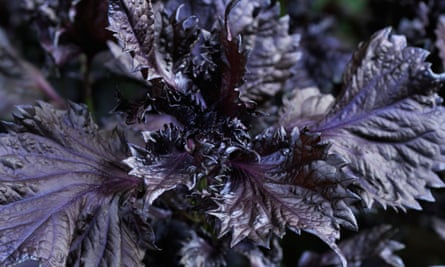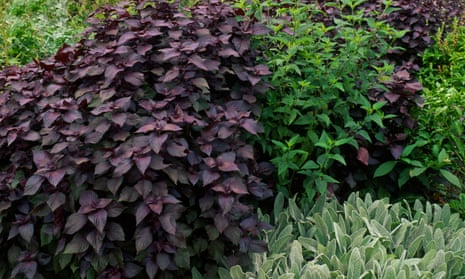Shiso perilla, better known as shiso in Japanese, tai to in Vietnamese and kkaennip or ggaenip in Korean, is one of those herbs that, if you know of it, you rave about and have myriads of recipes, including one for mojitos. I am experimenting with shiso soda as we speak. To everyone else it’s the herb that looks like nettles you’ll have tasted perhaps as tempura or wrapped around a fancy bit of sushi.
But it is far more than a garnish and once you get a taste for it, you may find you want a ready supply, so it makes sense to grow your own. If you don’t fall in love with its taste, you will with its looks. It’s a very handsome plant.
There are two main types of perilla: Perilla frutescens, the standard red and green forms, and P. frutescens var. crispa, which is the curly purple-leaved form often used in bedding displays (the Victorians were very fond of it).

The green form is more flavoursome and the one most widely used in cooking. The taste is hard to pin down – it is in the mint family and there’s definitely a strong note of that, as well as coriander, basil, cinnamon, anise, something a little perfumed and a hint of citrus. It’s odd and not like anything else, but it is quickly very addictive.
The red and purple forms are traditionally used in pickling where it tinges everything a violet hue, including umeboshi, the Japanese sour plum pickle. Saying that, the baby leaves of these make a delightful garnish and it’s worth growing them as a microleaf for this reason.

If you want large leaves, though, you’ll need to give them space, 30cm each way between plants, and both green and purple forms will do best in full sun, well-drained soil and can happily be grown in a pot – just keep pinching out the growing tips.
Soaking the seed for four to eight hours before sowing speeds up germination. Perilla needs to germinate in damp conditions at around 20C so it’s best started off in a heated propagator with either a propagator lid or a clear plastic bag to keep in moisture.
It also needs light to germinate, so cover it with the bare minimum of compost or surface sow. It should be up in 14 days and you can prick plants out at three to five leaves. Perilla is not frost hardy, so plant out well after any threat. Mature leaves can be harvested eight weeks after sowing and you’ll be able to continue to harvest all summer.

Comments (…)
Sign in or create your Guardian account to join the discussion